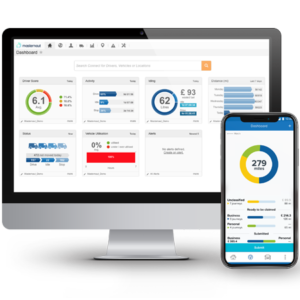Operating a commercial fleet can be extremely challenging, but with the use of vehicle tracking technology, the improvements to businesses can be wide-ranging. Masternaut reports.
Time is money
By producing telematics data, fleet managers can impact a number of key areas which can lead to significant savings. Construction companies can face challenges that other businesses who operate commercial fleets do not, in that the consequences of delayed delivery of a product or service can have massive knock-on effects.
Employing technology provides detailed and precise data that allows fleet managers to inform customers of delivery or pick up times accurately. Additional pickups can also be added based on the locations of fleet vehicles so as not to keep the customer waiting longer than necessary.
The access to this data also allows managers to plan routes more effectively in order to avoid areas which have shown issues, such as heavy traffic congestion, that can affect vehicle journey time.
Vehicle tracking systems can also help automate some of the traditionally labour intensive tasks that fleet managers are required to complete, such as filling in mileage claims and producing driver timesheets.
By saving time on deliveries and automating aspects of fleet management that are time intensive, businesses can make significant savings. With profit margins tighter than ever, this can be a valuable distinguisher between businesses in the same field.
 Safer driving has multiple benefits
Safer driving has multiple benefits
Driver safety, a key aspect of any fleet managers daily thought process, can also see dramatic improvements. In-cab coaching devices can be used to help drivers understand and optimise their driving style. This comparatively inexpensive driver training solution can improve driver behaviour without resource-intensive managerial involvement such as tailored training for individual drivers. However, if specific training for individuals is needed, the data allows managers to highlight those drivers who do need extra training and understand what kind of training needs to be done.
Alerting drivers about harsh acceleration, braking or cornering allows the driver to self-correct bad driving habits. This, as a result, makes drivers safer on the road and reduces the risk of an accident, not only for the commercial driver but for all road users. Considering professional drivers have a 30-40% higher incident rate than private drivers, a system that has shown to reduce speeding by 50%, in a study of 9000 vehicles, is a significant advantage for companies utilising the technology.
With public awareness higher than ever when it comes to environmentally green companies, the issue of saving fuel has never been more significant. Vehicle tracking allows for highly accurate fuel usage data to be accessed by fleet managers. As a result, the aforementioned areas such as route planning, in-cab coaching to correct harsh acceleration and other aspects such as vehicle idling can all be targeted to improve fuel efficiency.
Companies have already seen the results with GRAHAM Construction reducing their fuel costs by 11 per cent in just four months, crediting 6 per cent of the saving to reduced idling time and more efficient routes as a result of vehicle tracking. The other 5 per cent of the saving, GRAHAM believe, was due to improved driving technique in response to in-cab coaching systems.
 Data on the effect of speed on fuel consumption has shown a direct link between higher speeds and lower miles per gallon (mpg). Studies have found that vehicles are 3 per cent less efficient at 60 miles per hour and that figure rises significantly at 70mph to 17 per cent less efficient and 28 per cent less efficient at 80mph.
Data on the effect of speed on fuel consumption has shown a direct link between higher speeds and lower miles per gallon (mpg). Studies have found that vehicles are 3 per cent less efficient at 60 miles per hour and that figure rises significantly at 70mph to 17 per cent less efficient and 28 per cent less efficient at 80mph.
While the data produced lets fleet managers improve fuel efficiency, some have taken the technology further and used it to identify areas where they can make substantial changes to their actual fleet. ENGIE, who’s fleet covers over 1,800 vehicles used vehicle tracking to identify which vehicles would be suitable to be replaced with electric alternatives.
While this may seem like a big step that some companies are not ready for, the technology allows fleet managers to monitor maintenance requirements of their vehicles. Technical faults such as engine failure or tyre pressure can all be monitored and as such can improve vehicle efficiency as unexpected repairs that could sideline a vehicle for an extended period of time are reduced. A well-maintained vehicle is also much more efficient when it comes to limiting their impact on the environment and as a result, a companies carbon footprint.
Sustainability goals
There is no doubt that ‘sustainability’ and ‘going green’ are trending topics within all areas of business, but that can seem challenging when your business operates a commercial fleet, of any size.
Business looking to set their sustainability goals can utilise the vehicle tracking technology to target areas that can be improved on. Be that vehicle idling, inefficient routes taken, driver behaviour or vehicle maintenance.
It is important to remember that overestimating the savings businesses aim to make, can be counterproductive, and that sustainability targets should be realistic and achievable. It is also essential to set up a sustainability plan to have short-term targets that lead to a long-term goal, as this allows fleet managers to better track their progress over time.
The impact of vehicle tracking on the day to day operation of a commercial fleet can be both wide-ranging and highly crucial on the sustainability and profitability of a business. With increased social awareness on businesses for their environmental actions, employing vehicle tracking can allow businesses to improve their efficiency which can improve not only their margins but also public perception.
For more information on Masternaut, click here.









